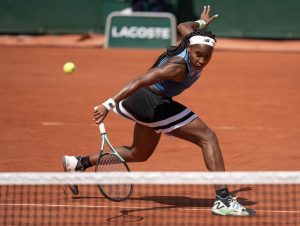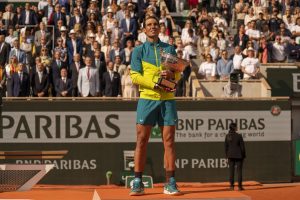And so the tennis season proper ends, with Rafael Nadal winning the US Open, thus matching Roger Federer’s haul of two Majors in 2017. This year’s men’s singles event may have been the most denuded men’s Major since the 2002 Australian Open, when early exits for Lleyton Hewitt, Pete Sampras, et al allowed Sweden’s Thomas Johansson to win his only Grand Slam event. Nevertheless, winning it still took Nadal to 16 in his battle of the ages with Roger (who is still ahead, just, on 19) to win the most Slams ever. It whets the appetite beautifully for 2018.
But of course the season is not over yet. There is still the “Asian swing” of the year, which includes important tournaments in China and Japan, before the return to Europe for the final Masters event of the year, in Paris at the end of October, the ATP Tour Finals in London at the start of November and–for those men and countries still standing–the Davis Cup Final at the end of November.
After such a momentous year on the men’s tour, when Federer and Nadal seemed to achieve the impossible and rewind 10 years to their glorious 2007 (when Federer won three Majors to Nadal’s one and they contested fine French and Wimbledon finals), it is hard not to think of the remainder of this year’s ATP circuit almost as an afterthought. And nobody wants to be an afterthought, especially not the burgeoning Asian tennis scene, which the ATP and ITF rightly regard as one of the prime markets for expansion of the game in the future.
Surely, therefore, it is time to revise the season to prioritise the Slams, such that the tour builds inexorably and inevitably to a glorious Autumn or Fall, with the last three big events–the US Open, the WTA Tour Finals, and the Davis Cup Final–following each other in swift succession to end the year in the most lavish of style.
It is not impossible to achieve this revision or redrawing of the men’s calendar; in fact, given goodwill by all the parties involved (which, granted, is not always easy to achieve), it is not even that difficult. Essentially, what is required is a rejigging of the current season to put the Asian swing events at the start of the year, as a build-up to the first Major of the year, the Australian Open, which would be moved to March or April. That would make the big Asian events appetizers rather than afterthoughts, in the same way that the main European clay court events (Madrid, Rome, etc.) all build to the greatest clay court event of all, the French Open.
Admittedly, this would mean moving the Australian Open from its current position at the start not only of the tennis calendar year but the sporting calendar year, when it perhaps garners more global attention than it would in the Spring. Nevertheless, the Australian Open has moved throughout the year many times in its long history; as late as 1985, it was the last Major of the year rather than the first, taking place in November/December rather than January/February. This would be the final, logical change, which would still maintain the tournament’s position as the first Major of the year.
The other significant changes to the calendar would fall into place relatively easily. The clay and grass court seasons would remain essentially the same, but with an extra week’s break between the end of Wimbledon and the start of the North American hardcourt season. Consequently, the US Open would take place in mid to late September rather than late August/early September. (New York is beautiful in late Summer, but it is even more beautiful in the Fall.)
With the Asian swing events having moved to the start of the year, the Autumn would then be freed up for a spectacular finish. The WTA and ATP Tour Finals could take place in early to mid October, with the Paris Masters also moving forward a month or so to be the perfect preparation for them (being another indoor event). Then, there could be a final month of Davis Cup action, with the world’s top 16 tennis nations competing against each other in a genuine “World Cup of Tennis,” which at a single stroke would restore the prestige of the game’s greatest team event.
I freely admit that there remain problems to be resolved, notably the scheduling of the “Sunshine Double” tournaments in America (Indian Wells and Miami), which are currently held in the Spring. Indian Wells, in particular, prides itself on being “the Fifth Major” and so Larry Ellison, its patron, would not be easily assuaged by talk of moving it to another part of the calendar year. But surely it is worth rejigging the so-called “Fifth Major” for the benefit of the four actual Majors?
That, ultimately, is the real reward for revising the men’s tour. (And if it was revised, the women’s tour would surely soon revise itself along similar lines.) Regardless of the time-bending efforts of Federer and Nadal, this year’s US Open showed that time is finally catching up with the rest of men’s tennis, with so many of the top players (including Djokovic, Murrary and Wawrinka) withdrawing from the year’s final Major through injury. If that is not to become commonplace, revising and most importantly shortening the men’s tour is essential.
This winter will mark the fiftieth anniversary of the last seismic shake-up in tennis, when the old amateur game finally went fully professional in 1968. Half a century on from that ground-breaking redrawing of the tennis landscape, it is time for another one, to reflect the fact that in the last five decades tennis has become a truly global game. (It is now second only to football, or soccer, for its truly global reach and popularity.) Redrawing the calendar along the lines that I have described would create a genuinely global tour that ran from late January/early February to mid-November (or October for those players who either did not want to play Davis Cup tennis or whose countries were not in the world’s top 16). In turn, that would create a true off-season for the very first time, which would allow players to rest up at the end of the year, helping them to prolong their career and, as a result, almost certainly increasing the standard of tennis all year round.
As Jonathan Swift once said of his idea to sustain the rich by feeding them the babies of the poor, it’s a modest proposal. Unlike Swift’s plan, however, it is not a satirical proposal at all, but a genuine attempt to at least stimulate some long-overdue thinking about how to cure some of the game’s worst ills, from an increasing rate of injury among the top players to the inevitable tailing-off of the tennis year after the US Open. Whatever the difficulties (and, as I have acknowledged, there are some genuine hurdles to overcome) of implementing this kind of plan, implementing it is none the less essential, to sustain and even improve tennis in the 21st century and the post-Federer and Nadal era.






